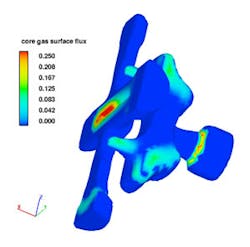Binder loss in two internal cores of a valve iron casting
Spatial plot of core-gas pressure at 5 sec. A two internal core assembly was bottom filled in the simulation in 1.5 sec. The gas pressure in the saddle core is roughly double what it is in the T-core. The vertical drill in the T-core along with one T-core print is very effective in venting all the T-core binder gas. The saddle remains inadequately vented in this design.
Filling of an open flask partial V8 aluminum block assembly. The two cores form the water jacket cavity of the block. The flask is bottom filled in 20 seconds …
… and the water jacket core when unvented blows gas into the metal during fill (Fig. 3b).
The potential for defects to be introduced into castings as a result of gasses generated from cores and molds is an important and often-neglected aspect of casting design. It is especially important in iron and aluminum castings. Having a way to predict (and thereby avoid) defects caused by core gas, and to simulate associated foundry processes, can lead to significant cost savings.
Working with engineers from Caterpillar, General Motors and AlchemCast (URL), and with researchers from University of Alabama, Flow Science (URL) developers implemented a core-gas model to enhance the advanced casting modeling capabilities already present in their flow modeling software, FLOW-3D. This model is now available in the latest release, FLOW-3D, version 9.4.
Modeling Castings with Resin-Bonded Cores — The core-gas model in FLOW-3D allows users to monitor progress of resin binder degradation in sand cores. The loss of binder corresponds to a loss of core strength. When monitored together with filling and freezing of the casting, the model is also a predictor of potential gas blows into the molten metal. This potential for gas defects is computed together with core-gas flow and core-gas pressures.
Modeling Castings with Cores — Resin-based binders of sand produce gas when heated by molten metal. Without proper mold/core venting, this gas may result in gas porosity in a casting. This is most likely for cores that form thin interior features of castings that heat up quickly and have long venting paths. The core-gas model in FLOW-3D is designed to predict the possibility of such gas defects and is intended to help design core venting that would evacuate safely all the binder product gas from the cores.
The core-gas model predicts defects for resin-bonded cores in iron castings (Fig. 2) and in aluminum castings (Figs. 3a and 3b). It works concurrently with the filling and solidification models in FLOW-3D and computes binder-gas generation and flow during and after the end of casting fill.
Real-World Data and Verification — An essential part of developing the new model was to use real-world data to verify the numeric results of the model. AlchemCast and GM provided Flow Science with experimental data that was used to develop and then validate the new model. Since the early stages of model development, project leaders from GM and Caterpillar used beta versions of the model to test and to help refine and verify the results. These efforts have greatly enhanced the accuracy of the model and proven its use and reliability in foundry operations.
